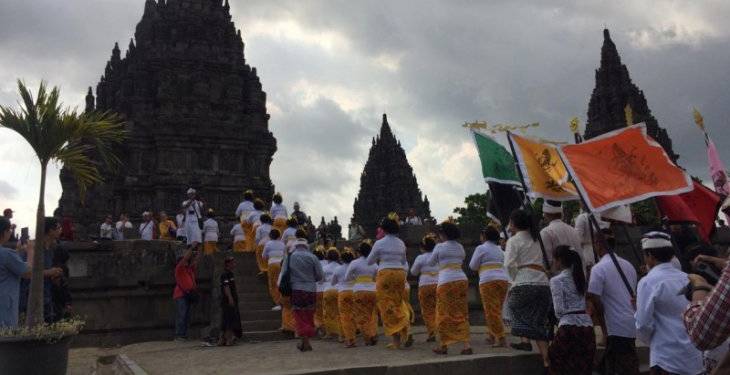In what shall be marked as a red-letter day in the history of Indonesia, a Hindu temple was restored in Indonesia after more than 1000 years. For the first time in more than 1100 years, the sanctification ceremony or the Abhishekam was performed at the Prambanan Temple complex, which is located between Sleman, Yogyakarta, and Klaten, Central Java, starting from 9 November.
To quote Made Astra Tanaya, a member of the committee that performed the Abhishekam, “After we discovered the inscription written on the day the temple was established, which is November 12, 856 AD, along with rituals conducted, Hindus then prepared to perform the same ritual. So it is basically to commemorate temple’s inauguration by Rakai Pikatan Dyah Seladu back in that year.”
The Prambanan Temple complex is one of the largest temples dedicated to Bhagwan Shiva around the world.
Built-in the 9th century AD, Prambanan Temple complex comprises Prambanan Temple (also called Loro Jonggrang), Sewu Temple, Bubrah Temple and Lumbung Temple. Prambanan Temple itself is a complex consisting of more than 200 temples.
All the mentioned temples form the Prambanan Archaeological Park and were built during the heyday of Emperor Shailendra’s powerful dynasty in Java in the 8th century AD. These compounds are located on the border between the two provinces of Yogyakarta and Central Java on Java Island.
Prambanan Archeological Park is a series of temple complexes, which like the iconic Angkor Wat of Cambodia, is festooned with reliefs illustrating the Indonesian version of the Ramayana epic, which are masterpieces of stone carvings. These are surrounded by hundreds of shrines that have been arranged in three parts showing high levels of stone building technology and architecture from the 8th century AD in Java. With over 500 temples, Prambanan Temple Compounds represents not only an architectural and cultural treasure but also a standing proof of past religious peaceful cohabitation.
The temples collapsed due to earthquake, volcanic eruptions and a shift of political power in the early 11th century, and they were rediscovered only in the 17th century. These compounds have never been displaced or changed. Restoration works have been conducted since 1918, both in the traditional method of interlocking stone and modern methods using concrete to strengthen the temple structure. Even though extensive restoration works have been done in the past and as recently as after the 2006 earthquake, great care has been taken to retain the authenticity of the structures. The site was declared as a UNESCO World Heritage Centre in 1991.
As such, the ritual of Abhishekam as performed in the temple complex is considered as a major turning point in returning the energy for both human beings and Mother Nature, said Tanaya, who officiates as the coordinator of the Indonesian Parisada Hindu Dharma (PDHI) Yogyakarta. It was a series of rituals which began on November 9, with the performing of Matur Piuning ritual as a way of invoking the permission of the ancestors.
The ceremony further continued with the spectacle of the eternal flame of Mrapen and holy water of eleven wellsprings around the area starting from the Boko Temple to the Prambanan temple where people then performed a prayer and Pradakshinam or circumambulation of the sanctum sanctorum. The main ritual was held on November 12 with the offerings as mentioned in 25 inscriptions of Hinduism during the Mataram Kingdom era.
The restoration of the temples, as well as the sanctification of the temple complex, as performed recently, indicates the essence of Sanatana Dharma that is still alive in the Far East. Though Indonesia is a Muslim majority, unlike their western counterparts, it hasn’t deleted its native culture and the original ancestry from the civilizational history even if it’s Muslim today. Probably that is why, even today, there are Sanskritized names of Muslim people, and given that this ceremony has performed in the Muslim majority island of Java, this also sends an inspiring message to us Indians, who are slowly deviating themselves from their native culture.
Like Indonesia, there are many temples which are lying in ruins, and they need to be reclaimed, whether they are underneath the soil, or have been replaced partially by mosques. This can be done even without souring relations with any community. What Indonesia has done is to nurture and respect their cultural heritage, something which we Indians need to take inspiration from, especially in the light of the recent Ayodhya verdict, which is now paving way for the historic restoration of the Ram Janmabhoomi complex.


































You’ll are TRUELY FRUSTRATED ID—-!